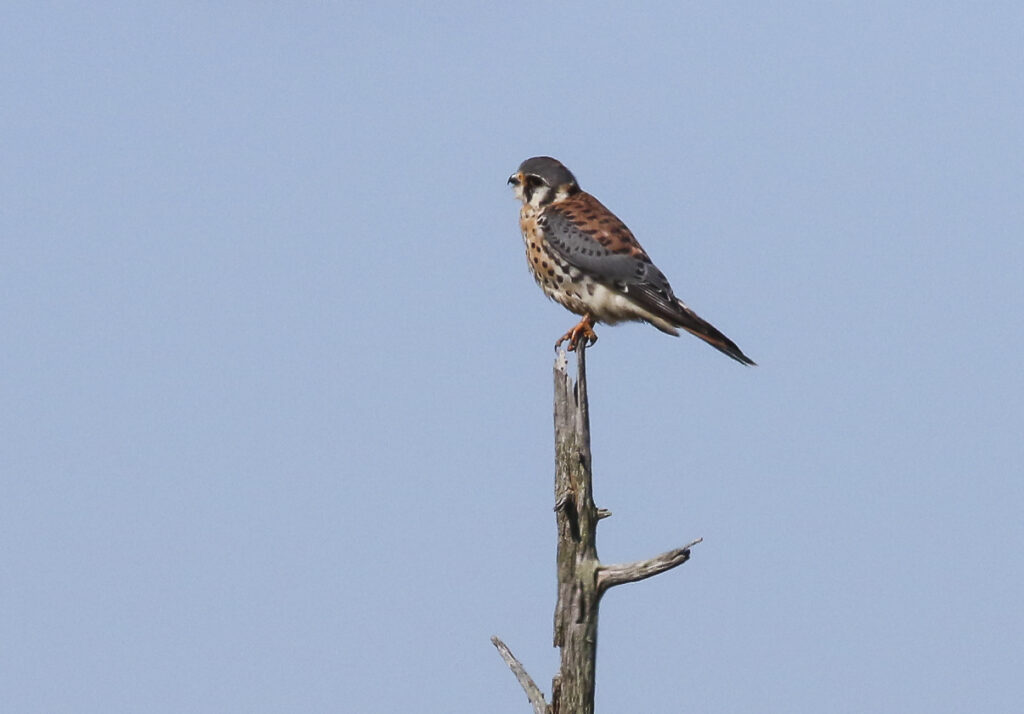The Smallest Falcon

By Wayne Bierbaum
Egypt Road, just outside of Cambridge on the Eastern Shore, is the typical route I take to the entrance of the Wildlife Drive at Blackwater National Wildlife Refuge. Of the three routes to the refuge, I drive that road because of a particular row of power lines that follows it on the west side. Starting in November through the end of February, the smallest and most colorful bird of prey likes to use the lines as a hunting perch. Although I have spotted the bird there many times, it is so wary that it is all but impossible to get a photo.
The American kestrel was previously known as a sparrow hawk but that name was dropped as it is properly classified as a falcon, the smallest of the family. There are several differences between a hawk and a falcon. Falcons have a notched beak and hawks have a smooth one. Falcons have pointed wings and tend to fly very quickly (over 60 mph); hawk wings are more rounded and they tend to soar and fly slower (under 40 mph). Falcons usually dispatch prey with their beak and hawks have stronger talons and dispatch their prey by a strong sharp grasp.
Although the American kestrel can fly very quickly, they have a remarkable ability to hunt by hovering in place. Many birds can do in-the-wind hovering but the kestrel’s thin long wings allow it to do so by barely twitching them. It is remarkable to see. From a motionless position in the sky, the bird can drop down into the grasses to grab its prey.
The kestrels are about the same size as a mourning dove. They are sexually dimorphic—meaning the males and females exhibit different physical characteristics. In American kestrels, the females are larger and less colorful than the males. The males have a blue-gray cap and sides, with red backs and tails, and two vertical bars on each side of their cheek that hide their eyes. They are very handsome birds, yet appear delicate.
American kestrels mostly feed on insects, like grasshoppers, but they will hunt small snakes, lizards, birds and rodents. Their hunting grounds are open fields which is why they are seen on power lines next to fields. I have seen kestrels chasing and grabbing large dragonflies out of the air near ponds; several of them ate the dragonflies while in flight.
Kestrels nest in cavities like abandoned woodpecker nests. They lay up to four eggs and after hatching the young are attended to by both parents. A month after hatching, the young are able to fly but are still fed by the parents. During that period the young will line up on a branch to be fed. After another two weeks, the fledged birds will pretty much be on their own.
The American kestrel is the most common falcon and has stable populations in the central and western states but in the east, especially the Northeast, their population has declined. The population in the New England states is estimated to be only 10 percent of its 1970 numbers. Locally the decline is estimated to be 31%.
The cause of the decline is not completely understood but is likely a combination of events. Loss of meadow lands and pesticide use causing a decline in insects are the most cited causes. To help increase the population, many states have started up nesting boxes and perches in suitable fields.
The first kestrel I have seen this fall was in Cape Henlopen State Park but I checked the eBird Range Map and there have been recent sightings along Egypt Road near Cambridge. I think it is time to take a drive.
